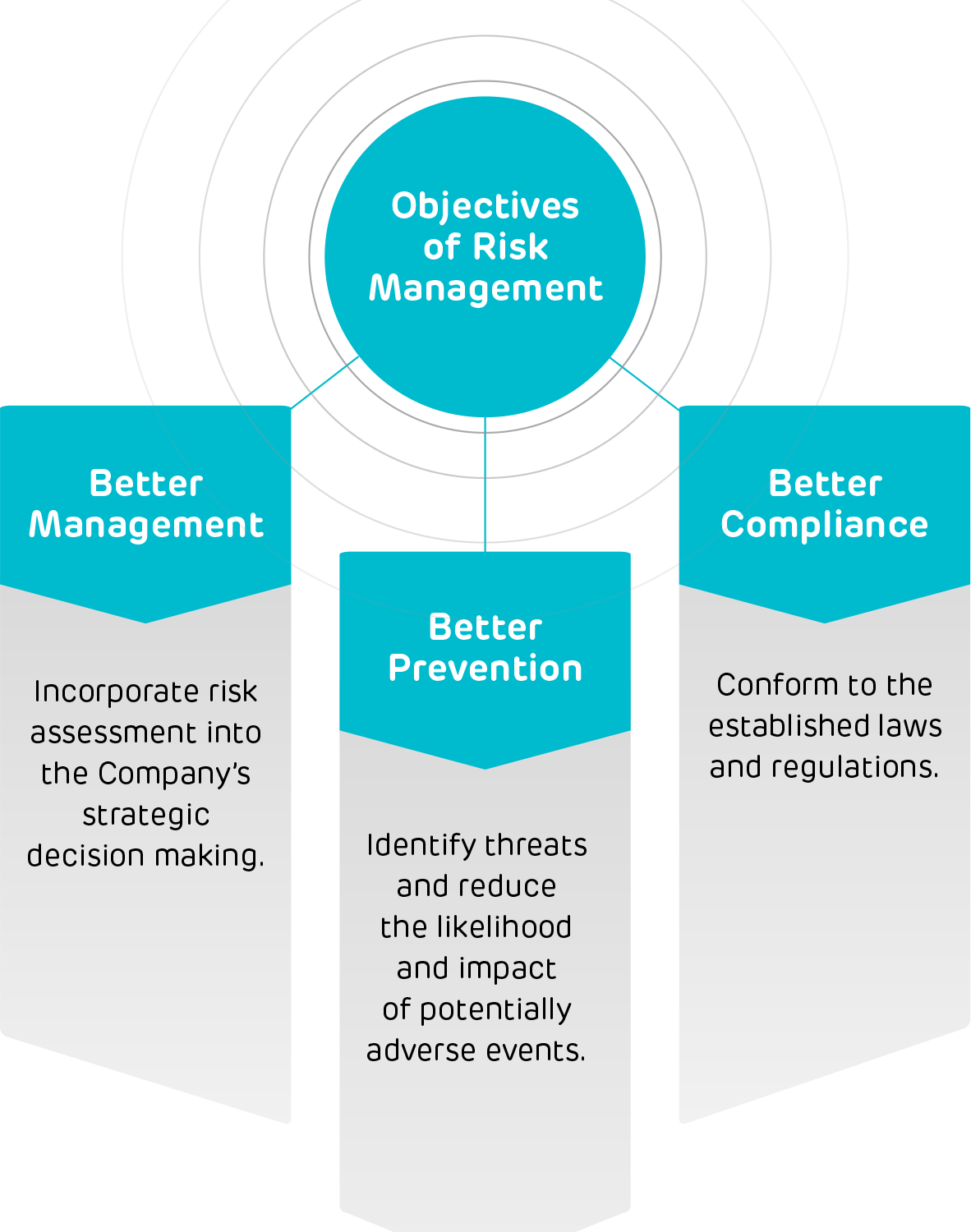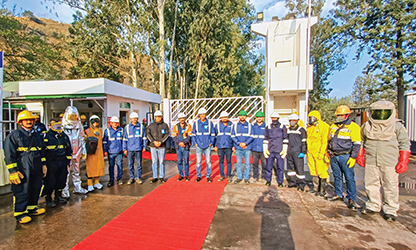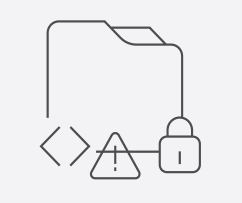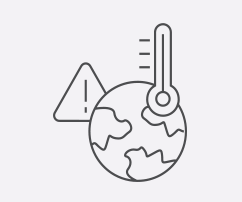Ambuja Cements has instituted a robust Enterprise Risk Management (ERM) framework to proactively identify, assess and mitigate risks that could impact its operations. This strategic approach enables the Company to anticipate both internal and external factors that may influence its performance and long-term growth.
Risk Management Approach
The Company’s risk management process is comprehensive and systematic, incorporating risk mapping, environmental scanning, and detailed assessments. Risks are evaluated using a 3x3 matrix, categorising them into high, medium, and low severity based on their likelihood and impact.
Each department plays a vital role in this process, evaluating its current and future risk landscape while identifying both risks and opportunities. These insights are then consolidated into a comprehensive risk profile, offering an organisation-wide perspective.
Ambuja Cements formulates targeted mitigation strategies for critical risks, ensuring timely and effective responses. Senior management closely monitors the intensity of identified risks, ensuring they are adequately addressed. Throughout the process, the Company maintains stringent controls to ensure operational efficiency, regulatory compliance, and overall organisational resilience.

Risk Management Framework
Enterprise Risk Management (ERM) is a core element of the Adani Group’s policy framework.
Through a systematic and impartial approach, risks are evaluated and managed with the support of various corporate functions.
This ensures that all significant risks are thoroughly identified, assessed, prioritised, mitigated, monitored and reported.

| Risk Identification and Assessment | Risk Prioritisation & Mitigation Planning | Risk Monitoring & Control |
Communication & Continuous Improvement |
|---|---|---|---|
Identify and evaluate
potential risks that could
affect operations and
business objectives.
|
Prioritise identified
risks and formulate
mitigation strategies.
|
Continuously monitor
risks and ensure effective
implementation of
mitigation actions.
|
Foster a risk-aware
culture and continuously
improve the risk
management process.
|
Risk Governance
Ambuja Cements takes a proactive approach to risk governance, aligning risk management with its defined appetite and tolerance. Through a consistent and rigorous risk assessment process, the Company empowers management to identify, evaluate, and mitigate both internal and external risks, ensuring regulatory compliance and operational efficiency.
Risk governance is central to Ambuja’s strategy, enabling data-driven decisions based on risk ratings and the Company’s overall risk appetite. Quarterly reports to the Risk Management Committee, led by the CEO and CFO, ensure transparency and accountability.
Adopting both top-down and bottom-up approaches, Ambuja consolidates insights into a comprehensive risk view. The Risk Management Committee oversees the Enterprise Risk Management (ERM) process, monitoring the progress of mitigation actions. By focusing on a maximum of two critical risks per meeting, the Committee ensures a targeted and effective response, fostering agility in addressing issues and driving sustainable growth.
Risk Management Committee (RMC)
Ambuja Cements' comprehensive risk management framework is overseen by the Risk Management Committee, comprising majority of Independent Directors. The Committee monitors, reports, and mitigates ongoing risks, reviewing the Company’s governance structure, risk assessment, policies, practices and overall risk management plan. Constituted in line with the Companies Act, 2013, the Committee directly reports to the Board, assisting in the fulfilment of its risk management responsibilities. It is supported by four sub-committees:
Commodity Price Risk Committee
Reviews risks related to commodity price fluctuations, promotes risk awareness, and manages the Commodity Price Risk Management (CPRM) policy, updating it based on market conditions.
Reputation Risk Committee
Assesses and addresses risks to the Company’s reputation, fostering a culture of risk awareness and high ethical standards. It ensures potential conflicts of interest and reputation risks are promptly reported to the Risk Management Committee.
Legal, Regulatory & Tax Committee
Supports the RMC in reviewing the Company’s legal, tax, and regulatory matters, as well as overseeing tax and other regulatory compliance programmes.
Mergers & Acquisitions Committee
Assists the RMC in evaluating the Company’s acquisition strategy, reviewing proposed mergers, acquisitions, investments, or divestments, and assessing the due diligence process.
| Nature of Risks | Definition | Mitigating Factors |
|---|---|---|
Maintaining Market Position in a Dynamic Industry Environment
|
The Indian cement industry is highly dynamic, with rapid changes and industry consolidations that pose risks to Ambuja's market position. These risks are compounded by continuous capacity expansions. |
Ambuja Cements is proactively addressing these risks through its ambitious plan to achieve 140 MTPA by FY 2027-28. Recent capacity increases of approximately 20 MTPA have strengthened its market presence. The Company also focuses on brand enhancement through innovation and digitisation to maintain competitiveness and profitability. |
Compliance with Changes in Regulatory Landscape
|
The regulatory environment is evolving rapidly, particularly with respect to climate change and environmental concerns. Failing to meet new standards could significantly impact the Company’s reputation and financial stability. |
To mitigate regulatory risks, Ambuja Cements is investing in modernisation and system upgrades across its operations. The Company is also addressing new emission standards (for dust, SOx, and NOx) set by the Ministry of Environment, Forest, and Climate Change, ensuring compliance and positioning itself as an environmentally responsible business. |
Health and Safety Priorities
|
Health and safety are critical for sustaining business operations and ensuring the well-being of employees. The Company's commitment to 'Zero Harm' requires continuous evaluation and improvement of safety measures and leadership presence. |
Ambuja Cements is actively working to improve safety standards through initiatives like Unchaai Kendra and the implementation of Life-Saving Safety Rules. Regular risk assessments, safety drills, and process evaluations help prevent accidents and ensure a safer working environment across all sites, driving continuous progress toward 'Zero Harm'. |
Fuel and Raw Material Security Challenges
|
The cement industry is energy and raw-material intensive, and any disruptions in the supply of fuel and key raw materials (like limestone and coal) could affect production costs and continuity. |
Ambuja Cements addresses fuel and raw material security by optimising its fuel mix and increasing the use of alternative fuels. The Company also invests in green energy solutions such as Waste Heat Recovery Systems (WHRS) and solar power. Additionally, Ambuja ensures a steady supply of raw materials through strategic acquisitions of mining leases, mitigating the impact of regulatory changes and market volatility. |
Cybersecurity Threats
|
As the digital landscape evolves globally, Ambuja Cements embraces innovation to enhance efficiency in the construction sector. Its digital transformation spans networks, cloud, data centres, business applications, and cybersecurity, ensuring best-in-class solutions for all stakeholders. |
Ambuja Cements prioritises cybersecurity by implementing advanced security solutions and an ISO 27k-certified cyber defence centre. Measures include identifying and blocking data leaks, securing AI tools, and maintaining air-gap backups. Regular system upgrades, policy updates and user training ensure a secure digital environment. |
Climate Risk
|
The Company is conscious of the physical and transitional climate change risks. In physical risks, Ambuja Cements considers acute (flooding, droughts, etc.) and chronic risks (water stress, heat stress, etc.), and in transitional risks, it considers regulatory, technology, market, and reputation risks which cause supply chain disruptions and power outages. |
The Company has established a robust climate governance structure that includes clear policies, committees, and defined metrics for climate-related risks. Ambuja has emergency plans in place and conducts regular training to ensure its systems are resilient to climate impacts. The Company continually monitors its performance to align with climate targets and adapt to changing environmental conditions. |
Natural Resource Availability
|
Ambuja Cements is highly dependent on natural resources like limestone, coal and fly-ash. Securing these materials while ensuring cost-effectiveness and quality is crucial for uninterrupted operations. |
To secure natural resources, Ambuja is investing in improving operational efficiency and enhancing resource utilisation. Initiatives like reducing the clinker factor and increasing thermal substitution rates help conserve resources. Additionally, the Company is investing in renewable energy and Waste Heat Recovery Systems to reduce reliance on non-renewable sources and ensure long-term sustainability. To ensure the availability of raw materials, the Company is also investing in coal and limestone mines. |
Energy Security
|
Energy security is a critical challenge for Ambuja Cements, given the energy-intensive nature of cement production. Volatility in energy prices, especially during the kilning and grinding processes, poses significant risks. |
Ambuja Cements is mitigating energy price risks by diversifying its fuel mix, increasing the use of alternative fuels, and improving energy efficiency across its operations. The Company also evaluates various energy procurement options to minimise reliance on fossil fuels and ensure cost-effective, stable energy supplies. By managing its energy resources, the Company aims to sustain competitiveness in the dynamic cement industry landscape. |
Project Execution
|
Meeting the ambitious target of 140 MTPA by FY 2027-28 requires efficient execution of large-scale projects. Ensuring these projects are completed on time, within budget, and with high safety and quality standards is essential for business growth. |
Ambuja leverages synergies with the Adani Group's project management expertise to execute large-scale projects efficiently. A robust cash flow, driven by internal accruals, ensures timely financing for these projects. The Company uses the EPC (Engineering, Procurement, and Construction) model to collaborate with world-class suppliers, while standardising and simplifying internal processes to achieve maximum speed, scale and efficiency in project delivery. |